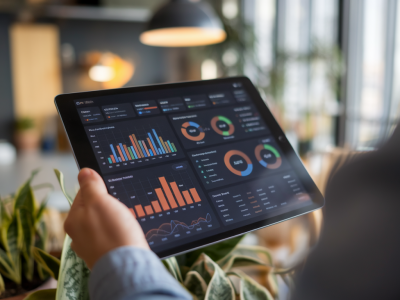
As a marketer, I know how challenging it can be to make sense of the ever-increasing amount of data available to us. Whether it's customer behavior, campaign performance metrics, or industry trends, the ability to visualize this data effectively can make all the difference in understanding insights and driving strategic decisions. Over the years, I've tried countless tools, and today, I'm excited to share some of my favorite data visualization tools that every marketer should know about. These tools are not just handy; they are game-changers in turning data into impactful, actionable stories.
Tableau
Tableau is hands-down one of the most powerful data visualization tools on the market. What I absolutely love about Tableau is its versatility and intuitive drag-and-drop interface. Whether you’re working with large-scale datasets or simpler metrics, Tableau can handle it all with elegance. As a marketer, you can connect Tableau to almost any data source—CRM platforms like Salesforce, spreadsheets, or even cloud databases—and create dynamic, real-time dashboards.
One of the features I appreciate the most is Tableau’s ability to blend different datasets seamlessly. For instance, I once used it to combine social media metrics with detailed customer demographic data, and the insights I uncovered were instrumental in segmenting our campaigns more effectively. While Tableau comes with a learning curve and may not be the cheapest option, its power and flexibility are worth the investment.
Google Data Studio
If you’re a marketer who feels more comfortable sticking with Google’s ecosystem, Google Data Studio is a fantastic free option for data visualization. I use it extensively for projects that involve Google Analytics, Google Ads, and YouTube data. Google Data Studio makes it effortless to bring all your data into one place and create interactive dashboards that you can share with your clients or team members.
What makes this tool stand out to me is its ability to offer real-time updates. Imagine being in a meeting and seamlessly refreshing your dashboard data to address campaign improvements or shifts in performance. Plus, the prebuilt connectors for platforms like Facebook and Twitter ads make integrating multi-channel data a breeze. While it has fewer advanced features compared to Tableau, the fact that it’s free and directly integrates with Google tools makes it indispensable to so many projects I work on.
Canva
Now, if you’re thinking, "Wait, isn’t Canva more of a design tool?"—you’re absolutely right, but hear me out! Canva has stepped up its game with several data visualization features, including customizable chart templates and infographic builders. For marketers who aren’t data scientists and may not need the complexity of Tableau or Google Data Studio, Canva offers an accessible alternative.
One of my favorite uses for Canva is to create visually stunning, presentation-ready graphics for key stakeholder meetings or social media posts. Need to show campaign results and trends in a digestible format? Canva’s predesigned templates can turn even the dullest Excel sheet into eye-catching visuals. It’s perfect for communicating data in ways that resonate with non-technical audiences.
Power BI
Microsoft’s Power BI is another heavy hitter in data visualization. It’s an excellent choice for companies already using Microsoft’s suite of tools like Excel or Azure. What sets Power BI apart for me is its collaborative potential. For teams working on large-scale marketing campaigns, Power BI enables you to share insights across departments seamlessly—think sales, product, or customer support teams.
Power BI also excels in predictive analytics, using machine learning to provide insights into future trends. For example, I’ve used it to analyze the effectiveness of month-over-month marketing budgets while forecasting possible outcomes for upcoming quarters. It’s a solid tool for marketers who need robust reporting for both short-term and long-term strategies.
Infogram
Infogram is another accessible and user-friendly tool that I’m always quick to recommend, especially for marketers who prioritize speed and simplicity. It’s web-based, making it convenient to access from anywhere. What I adore about Infogram is its modern and crisp design aesthetic—a must when presenting data to clients or stakeholders who care about visual appeal as much as they do about the numbers.
The platform provides excellent integration capabilities for importing data directly from sources like Google Sheets or cloud storage services. I’ve used Infogram in situations where I needed to whip up a quick yet impactful infographic summarizing campaign performance metrics. Its drag-and-drop editor is straightforward, allowing you to create everything from pie charts to interactive maps in minutes.
How to Choose the Right Tool for Your Needs
With so many excellent options out there, deciding on the right tool can feel overwhelming. My advice? Start with your goals. Are you creating visuals for internal analysis or client presentations? Do you need real-time data updates, or are you looking for a tool that emphasizes aesthetics? Understanding your specific requirements will guide you to the tool best suited for the job.
If you’re working with massive datasets across multiple sources, tools like Tableau or Power BI will offer the advanced features you need. For those seeking a cost-effective solution within the Google ecosystem, Google Data Studio is a no-brainer. Canva and Infogram, on the other hand, are ideal for creating presentation-ready graphics when time and simplicity are key.
One thing I’ve learned is that no single tool will fit all needs. I often mix and match—using Tableau for deep-dive analysis and Canva for creating visually appealing, high-level summaries. Don’t be afraid to experiment; the insights you uncover will justify the time spent learning these tools.
Remember, data visualization is more than just pretty graphs—it's about telling compelling stories that drive marketing success. With the right tools, you can not only uncover critical insights but also communicate them persuasively to your audience, be it your internal team, clients, or stakeholders.

